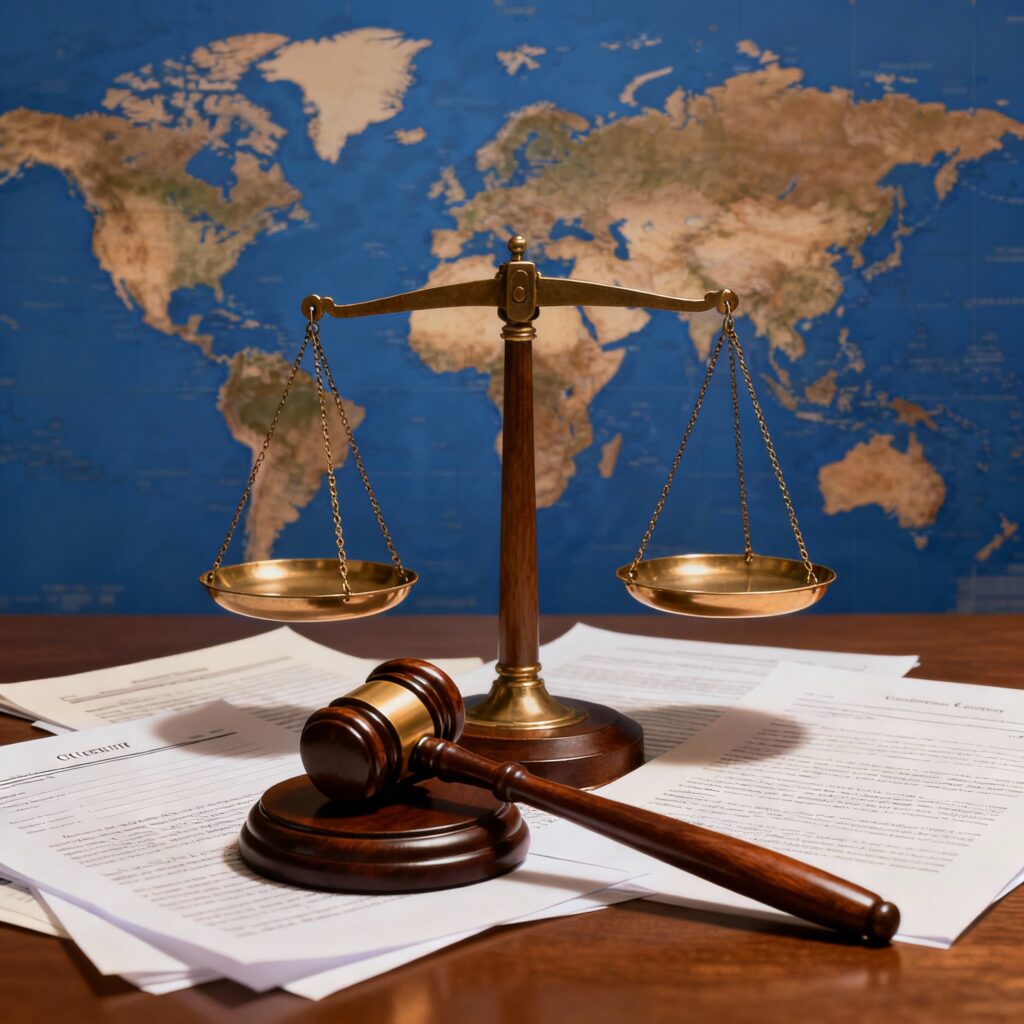Published On: October 27th 2025
Authored By: Pragati Singh
National Law University Meghalaya
Abstract
This newfound commercial and military expansion era in outer space presents humankind with an unprecedented legal frontier. Rapid advancements in space technologies, with the growing involvement of private entities and rising geopolitical rivalries, have rendered existing international legal frameworks vaguely outdated and have hence led to a demand for immediate legal preparation. No longer is the “New Space Race” a state-driven one; it is deeply influenced by the private sector, creating a more complicated web of legal and ethical challenges that traditional space law was never built to tackle. As there is marked proliferation in operations of the “twilight zone between air law and space law,” the international community must coordinate to come up with a coherent system of governance to ensure its permanency, safety, and utility for peaceful purposes, considering vexing issues such as resource exploitation, intellectual property, space debris, and militarisation.
Keywords – Outer Space Law, New Space Race, Private Sector Involvement, International Governance, Space Militarisation, Resource Exploitation
Introduction: From State-Centric Exploration to the New Space Race
The contemporary “New Space Race” differs from its Cold War predecessor primarily owing to the significance it accords to the private sector[1]. In the 1950s through the 1970s, space activities were essentially state activities, and the trend has considerably changed, with companies like Blue Origin, Nanoracks, Northrop Grumman, Axiom Space, and SpaceX now shaping the new face of innovation and commercialisation of space activities. This change raises deeper legal concerns, generating “complex layers of legal and ethical challenges” that traditional space law had never contemplated[2]. The increasing role of private entities raises a pressing question before the international community: How can either the existing or new international legal frameworks regulate private exploitation of outer space in such a manner as to guarantee its long-term sustainability, safety, and peaceful utilisation for the good of all humanity? The urgency comes from the fact that this commercialisation and militarisation pose a “profound test for international law[3].”
Existing Legal Framework and Its Limitations
The Corpus Juris Spatialis is a group of United Nations treaties, including the Outer Space Treaty of 1967, the Rescue Agreement of 1968, the Liability Convention of 1972, the Registration Convention of 1975, and the Moon Agreement of 1979[4]. The Outer Space Treaty is regarded as the main framework of international space law, accepting some principles from customary international law and stamping these upon mankind: outer space exploration and use shall benefit all countries. The most important provisions in the OST are Article II, which states that outer space is not subject to national appropriation by claim of sovereignty, use, or occupation, and Article VIII, which lays down jurisdiction and control of space objects by the State that has registered them[5]. However, the OST lacks enforceability in many central areas and relies on broad principles drafted in an era when states were the only significant actors[6]. Its provisions on non-appropriation are interpreted very differently concerning private property, where many recent accusations in resource extraction have arisen. The 1979 Moon Agreement, in turn, would have tried to create a more concrete regime and included the concept of the Common Heritage of Mankind (CHM) with respect to the Moon and its resources, to be explored and exploited for the benefit of all countries with equitable sharing of benefits[7]. The CHM doctrine holds that natural resources “in place cannot become the property of an entity or person”. The Moon Agreement, however noble its ideals, is generally regarded as a “failed attempt” as it has not been ratified by any significant space power in its entirety, thereby severely limiting its practical applicability and distance from constituting customary international law[8]. The collectivist approach contradicts the monopolistic economic system that has been the backdrop for private commercial ventures. Furthermore, while upholding stringent requirements for state responsibility, the Liability Convention (1972) becomes a headache for courts, and the more complex involvement of various commercial actors and fragmented liability. The Registration Convention (1975), designed to mandate registration, suffers from inconsistent inter-state adherence and thus an incomplete inventory of objects in orbit, endangering traffic management. The existing treaties have set the foundation but fall short in providing clarity in an environment marked by swift technological advancement, inextricable association with private operators, and increasing synergy between commercial and military interests. The entirely unknown border between airspace and outer space as a set-off presents another massive challenge, wherein the applicable legal regime for activities in “very high altitudes” remains unclear[9].
Emerging Challenges of Commercialisation
Arising out of the commercialisation of outer space, the contemporary New Space Race throws several emerging challenges at space governance. A significant area of contention is the legal status of space resource exploitation. Whereas the Outer Space Treaty forbids “national appropriation” of any outer space territory and the Moon Agreement takes this further by disallowing natural resources in situ from becoming private property, four countries- the U.S., Luxembourg, United Arab Emirates, and Japan-have enacted their domestic laws enabling private space mining[10]. These four nations often draw analogies to the freedom of exploitation in the high seas and argue that the OST’s prohibition on “territorial” appropriation does not extend to ownership of the extracted resources. The Artemis Accords, a non-binding framework promoted by the U.S., would similarly permit private property rights for extracted resources, thus directly contradicting the CHM principle of the Moon Agreement[11]. These national strategies in divergence highlight blatant legal open gaps and contradictions that may result in conflicting claims and political fallout. Another poignant question is orbital crowding and space debris, which was declared one of the “major challenges”. Commercial launch and operation of mega-constellations, even though there is no information on particular episodes like the Starlink against OneWeb collision, seriously add to the menace by raising the possibility of collisions and, subsequently, creating more debris[12]. The inconsistent observance of the Registration Convention (1975) limits the conduct of traffic management[13]. Space tourism and sub-orbital flights further complicate things. The “legal ambiguity surrounding ‘sub-orbital activities'”, whether they pertain to air law or space law, has yet to be resolved. The International Law Association (ILA) Space Law Committee created the “Rules on Non-Orbital Spaceflight Activities,” which adopted a “functional approach” over a “spatial approach” for classification, concentrating on velocity and technology instead of fixed altitude[14]. However, differing regulatory approaches, such as the European Union Aviation Safety Agency (EASA) considering “Higher Airspace Operations” as aviation activities, exemplify the lack of a global consensus[15]. The legal status of “spaceflight participants” in commercial space tourism also remains vague, with calls for clarifying the applicability of the Rescue Agreement. Hence, the militarisation of outer space poses “existential threats to peace and stability.” While the OST recognises the principle of peaceful uses, there remains a contest as to how peaceful uses should be defined; the sources do not explicitly detail particular ASAT tests or specify the existence of binding enforcement mechanisms to prevent a space arms race. Conceptually speaking, the problem of new businesses potentially “breaking the rules” extends to state actions in militarisation, where self-interest might trump cooperative principles. No specific details are given about India’s 2023 Space Policy in the sources provided; however, in view of its growing space capabilities and commitment toward peaceful uses, India can take up leadership to advocate for a balanced and inclusive space governance framework.
Towards a Sustainable and Enforceable Legal Framework
In view of the very many challenges, a proactive multi-pronged approach to reforming legal systems is needed. Strengthening and empowering existing international organisations such as UNOOSA and UNCOPUOS must take precedence over creating brand new bodies. The role of UNOOSA as a key facilitator is underscored by its mandate to foster international cooperation and provide assistance in developing legal and regulatory frameworks[16]. Conversely, UNCOPUOS should be pressured to advance discussions to the level of legally-binding instruments rather than the principal stage only. Amendments to existing treaties or protocols are “likely to be more promising” than establishing an entirely new regime on a comprehensive scale. Amendments to these treaties must clearly spell out the legal recognition and responsibilities of private entities and “spaceflight participants,” and how states can discharge their obligations in authorising and supervising non-governmental activities. Therefore, it will be imperative to reach a clear international consensus on ownership of space resources after extraction, possibly through an interpretive agreement of OST Article II, balancing the non-appropriation of territory with the economic incentive for resource utilisation[17]. Similarly, a long-standing debate on the boundary between airspace and outer space should be resolved by adopting a “functional approach” based on velocity and technology rather than fixed altitude to clear jurisdictional lines. The current regime of strict liability requires modifications to adapt to the peculiarities of multi-actor commercial operations, possibly providing for a form of shared liability among private operators, manufacturers, and launching states. Next, a comprehensive, legally binding treaty on space debris management should be concluded, which would include, amongst others, mandatory reporting, clear guidelines for active debris removal, and financial incentives for sustainable practices, along with stricter enforcement and penalties for non-compliance[18]. The global STM framework must be established for collision avoidance and safe operations, standardising rules for the launch, operation, and de-orbiting through a dedicated international body or enhanced coordination by the UNOOSA. Given the OST principle of peaceful uses, outlawing testing and use of ASATs and other offensive counter-space capabilities, enhancing verification mechanisms, and bringing about transparency in the military use of space to avoid a space arms race, deserves consideration as a novelty. Intellectual property issues in outer space, specifically copyright, must be subjected to a clearer legal regime. Sterling’s proposals of a “WIPO for Outer Space,” with a “Space Copyright Tribunal and a Space Copyright Bureau” and a “stand-alone law for extraterritorial rights,” is an innovative proposal tackling these new challenges without engaging some of the difficulties posed by competing legal principles such as lex loci protectionis and lex loci originis[19]. Given the development of its capacities, commitment to peaceful uses, and the developing nation outlook, India is well placed to assume leadership in advocating for a balanced and inclusive space governance framework.
Conclusion: The Future of Space Governance
At this time, the increasing commercialisation and militarisation in outer space present an enormous predicament for the international community, as the very foundational principles enshrined in treaties like the Outer Space Treaty, while probably visionary for their times, now find themselves stretched technically due to issues they were not meant to accommodate, such as rapid ripening of private actors, contested claims on space resources, rising threat of militarisation, and the dying call of emergencies for space debris. This also indicates that while commercialisation has, in good measure, outrun international law, modern technological development has brought forth “many shortcomings and loopholes”. Proper legal preparedness will have to arise out of a shift of paradigm from aspirational principles to non-aspirational, concrete, and binding mechanisms. Such reforms would have to be drafted towards “foreseeable and transparent requirements” that assist the emerging space industry while affording human safety, property, and the environment. The reform process would have to consider sustainability and equity so that the benefits of space exploration are shared, respecting the spirit of a “province of all mankind”[20]. Thus, the international community must commit wholeheartedly to a legal reform, including strengthening existing governance bodies, targeted amendments to established treaties, and weighing the drafting of specialised instruments for space sustainability and militarisation controls[21]. If this is not done proactively, it will be a worse prospect for the promised space, turning into a domain of unbridled competition and irrevocable damage instead of a scar-free shared domain for humanity.
References
[1] Inesa Kostenko, ‘Current Problems and Challenges in International Space Law: Legal Aspects’ (2022) 3(1) Journal of Space Law and Policy 12
[2] Inesa Kostenko, ‘Current Problems and Challenges in International Space Law: Legal Aspects’ (2022) 3(1) Journal of Space Law and Policy 18
[3] Marco Franzoso, ‘Fly Me to the Moon . . . & Back: The Intricate Interplay between Copyright Law and Space Law’ (2021) 9 European Journal of Law and Technology 3.
[4] Treaty on Principles Governing the Activities of States in the Exploration and Use of Outer Space, including the Moon and Other Celestial Bodies (adopted 27 January 1967, entered into force 10 October 1967
[5] Treaty on Principles Governing the Activities of States in the Exploration and Use of Outer Space, including the Moon and Other Celestial Bodies (adopted 27 January 1967, entered into force 10 October 1967) 610 UNTS 205, arts II, VIII.
[6] Inesa Kostenko, ‘Current Problems and Challenges in International Space Law: Legal Aspects’ (2022) 3(1) Journal of Space Law and Policy 15
[7] Agreement Governing the Activities of States on the Moon and Other Celestial Bodies (adopted 18 December 1979, entered into force 11 July 1984) 1363 UNTS 3, art 11.
[8] Marco Franzoso, ‘Fly Me to the Moon . . . & Back: The Intricate Interplay between Copyright Law and Space Law’ (2021) 9 European Journal of Law and Technology 3.
[9] Irmgard Marboe, ‘Sub-orbital Activities – The Application of International Law in the Twilight between Air and Space Law’ (2020) 19(2) German Journal of Air and Space Law 65
[10] United States, Commercial Space Launch Competitiveness Act 2015, Pub L No 114-90, 129 Stat 704
[11] NASA, ‘Artemis Accords’ (NASA 2025) https://www.nasa.gov/artemis-accords/
[12] MIT Study, ‘MIT Warns SpaceX Could Lose Up to Two-Thirds of Starlink Fleet’ (TechNewsDay 2025).
[13] Convention on Registration of Objects Launched into Outer Space (adopted 12 November 1974, entered into force 15 September 1976) 1023 UNTS 15.
[14] International Law Association, ‘Non-Orbital Spaceflight Activities Rules’ (ILA 2024) https://www.ila-hq.org/en/documents/ila-draft-rules-on-suborbital-spaceflight-2024-06-03-complete-and-final-for-athens-1.
[15] European Union Aviation Safety Agency (EASA), ‘High Altitude Operations’ (2023) https://www.easa.europa.eu/en/light/topics/high-altitude-operations accessed 5 August 2025.
[16] United Nations Office for Outer Space Affairs, ‘UNOOSA Mandate’ (UNOOSA 2025).
[17] Treaty on Principles Governing the Activities of States in the Exploration and Use of Outer Space, including the Moon and Other Celestial Bodies (adopted 27 January 1967, entered into force 10 October 1967) 610 UNTS 205, art II.
[18] Convention on Registration of Objects Launched into Outer Space (adopted 12 November 1974, entered into force 15 September 1976) 1023 UNTS 15.
[19] J.A.L. Sterling, World Copyright Law (2nd edn, Sweet & Maxwell 2003) 658.
[20] Treaty on Principles Governing the Activities of States in the Exploration and Use of Outer Space, including the Moon and Other Celestial Bodies (adopted 27 January 1967, entered into force 10 October 1967) 610 UNTS 205, art I.
[21] United Nations Office for Outer Space Affairs, ‘UNOOSA Mandate’ (UNOOSA 2025).




